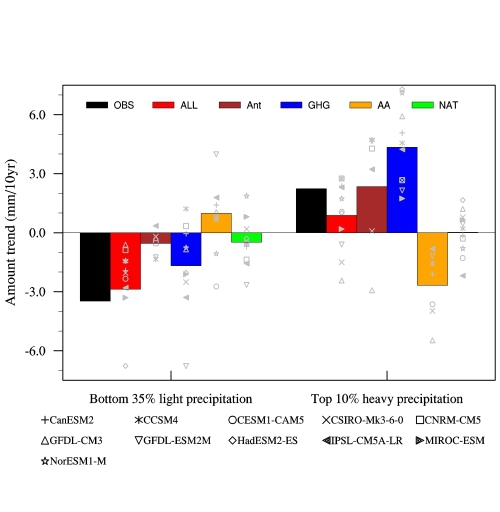Detectable anthropogenic shift toward heavy precipitation over eastern China
Date:2017-02-14
Global warming increases the water holding capacity of the atmosphere and thus precipitation characteristics are expected to change. Changing precipitation characteristics directly affect society through their impacts on drought and floods, hydro-dams and urban drainage systems. An understanding of the changes in precipitation characteristics is not only important for climate research but also of great significant merit in the management of water resources and agricultural activities.
“To address climate change, detection and attribution studies of precipitation are essential. Nonetheless, the detection of regional precipitation change has been a challenge, especially at regional scale. Whether anthropogenic climate change is manifested through a detectable effect on East Asian precipitation remains unknown.” Said the first author Dr. MA Shuangmei of a recent study published in Journal of Climate.
MA currently works at Chinese Academy of Meteorological Sciences. She received her PhD degree from the University of Chinese Academy of Sciences (UCAS). Supervised by her Ph.D advisor, Prof. ZHOU Tianjun from the Institute of Atmospheric Physics/Chinese Academy of Sciences, her Ph. D research focused on detection and attribution of anthropogenic precipitation change over China. Their recently published work was the first attempt to investigate the changes in the distribution of the daily precipitation amount over China during the last five decades using observation data sets. They and their American and European collaborators applied the optimal fingerprinting detection and attribution method to assess the anthropogenic contribution to precipitation changes, based on the outputs of the CMIP5 models.
“The results show that anthropogenic forcing has had a detectable and attributable in?uence on the distribution of daily precipitation amounts over eastern China (EC) during the second half of the twentieth century.” Prof. ZHOU Tianjun, who is the corresponding author of the paper, summarized their findings. “We have also found evidences suggesting that the observed shift from weak precipitation to intense precipitation is primarily due to the contribution of greenhouse gas (GHG) forcing, with anthropogenic aerosol (AA) forcing offsetting some of the effects of the GHG forcing.” Under GHG-induced warming, increased atmospheric precipitable water and enhanced land–sea thermal contrast cause the water vapor transport to EC from the adjacent oceans via southerly and midlatitude westerly winds to strengthen, thereby favoring heavier precipitation over EC. However, the countering effects of surface cooling induced by anthropogenic aerosols meant that some of this enhanced transport is cancelled out by AA forcing.

Linear trends of precipitation amount during 1956–2005 for the bottom 35% light precipitation at left and top 10% heavy precipitation at right averaged over EC. Black bars are for observations. Red, green, brown, orange, and green bars are for MME of the ALL, ANT, GHG, AA, and NAT forcing simulations, respectively. Gray symbols represent different models. (Ma et al., 2017)
“We should also note that while the GHG forcing to the observed precipitation change is attributable and detectable, the signal of AA forcing is not as robust as GHG due to the limitations of aerosol schemes used in the current state of the art models." ZHOU is hopeful that "the new models used in the Global Monsoons Modeling Inter-comparison Project (GMMIP) for the 6th Coupled Model Inter-comparison Project (CMIP6) would have improvement in this regard”.
Reference:
Ma, S., T. Zhou*, D. Stone, D. Polson, A. Dai, P. Stott, H. Storch, Y. Qian, C. Burke, P. Wu, L. Zou, and A. Ciavarella, 2017: Detectable anthropogenic shift toward heavy precipitation over eastern China. Journal of Climate, 30, 1381-1396, doi:10.1175/JCLI-D-16-0311.1 http://journals.ametsoc.org/doi/abs/10.1175/JCLI-D-16-0311.1
Contact: ZHOU Tianjun, zhoutj@lasg.iap.ac.cn
